Hunter Goes on the Attack
Police Union and City Administrator Argue Numbers, Public Safety
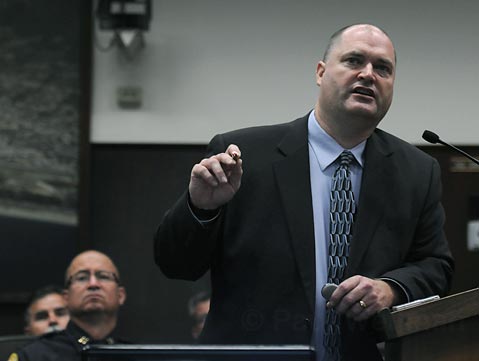
In a dramatic exhibition of high-stakes political theater, Santa Barbara Police Detective Jaycee Hunter delivered a two-hour monologue before the Fire and Police Commission Friday morning, charging that crime rates have soared over the past 10 years while the number of arrests have plummeted, all because City Hall has aggressively shrunk the number of officers the Police Department could hire.
On paper, the number of authorized cops has dropped from 150 to 140 in the past 10 years. But in the flesh, Hunter said, the number of actual sworn positions lost was 17. And that doesn’t count the number of civilian support staff — 24 — that’s disappeared in the same period of time. Because of that, Hunter charged, the number of reported crimes has increased, while the number of arrests has diminished. In addition, he said, the length of time civilians have to wait before a cop responds to a call for service has grown.
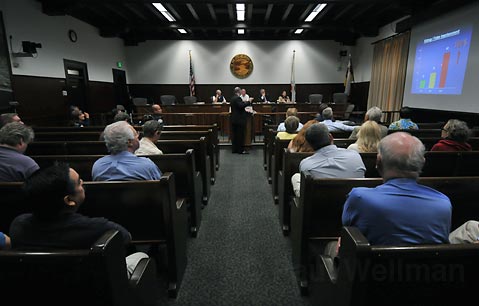
Friday’s meeting was the fist time the Fire and Police Commission has met in City Council chambers; typically, it gathers in the low-ceilinged basement of the Police Department into which few reporters ever descend. The meeting came as City Hall grapples with a $9-million budget shortfall, and two weeks before the city’s contract with the Police Officers Association (POA) — which Detective Hunter represents — expires.
City Administrator Jim Armstrong — and a majority of the City Council — are pushing the POA to make about $1 million in wage concessions, or about a 6 percent reduction in salary, benefits, and retirement pay. The union argued that Armstrong has exaggerated the extent of budget crisis in order to strong-arm concessions from the POA, concessions that the union insists are unwarranted. In fact, Hunter accused Armstrong of deliberately starving the city’s General Fund budget — sequestering millions of dollars, that could otherwise go to cops, into obscure and off-limit administrative funds — just so he’d have a pretext to cut the number of sworn police officers. “The purpose is to make it appear the only place to cut positions is the Police Department,” said Hunter.
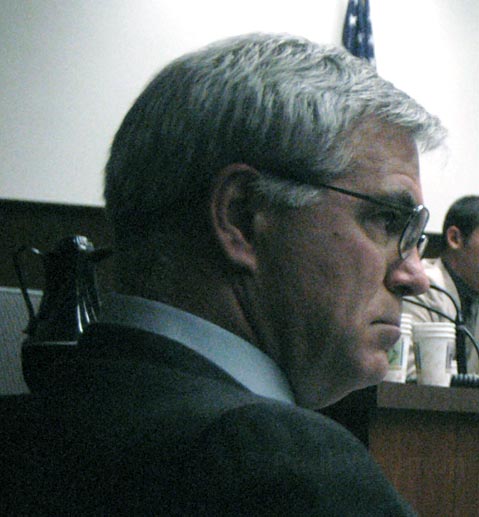
Normally, the POA is one of the most politically powerful unions on the South Coast and enjoys considerable access to and influence with councilmembers. But in many regards, this is a brand new City Council. Several of the new members were elected without any, or hardly any, help from the POA. And the union now finds itself without its staunchest supporter, former councilmember Iya Falcone, who stepped down in January. Many of the new councilmembers are viscerally affected by the severity of the recession; their support for public safety does not necessarily translate to support for public safety unions. In light of current budget realities, they contend that all employees — even police officers and firefighters — must share the pain. How far they’re willing to go when push comes to shove still remains to be seen.
Likewise, it remains to be seen what impact Hunter’s high-profile critique will have. But he certainly got Armstrong’s attention. Within hours, Armstrong delivered a three-page rebuttal — unprecedented for the publicly low-key city administrator. Armstrong said crime rates had not gone up as Hunter asserted. In fact, he said, there was a 5.6 percent drop in serious crimes from 2002 to 2008. He blamed the union’s success at the bargaining tables for any reduction in departmental manpower. Since 2002, he said, city funding for the Police Department has grown by 50 percent, or $11 million. Most of that, he said, went to increases in wages, benefits, and retirement. Cops who earned $72,000 a year eight years ago are now making $120,000. Armstrong rejected the notion that he was out to cut the Police Department budget, stating this was “simply untrue and not supported by the facts.” He concluded that Hunter’s remarks “do a disservice to the outstanding work performed by the men and women of the Police Department.”
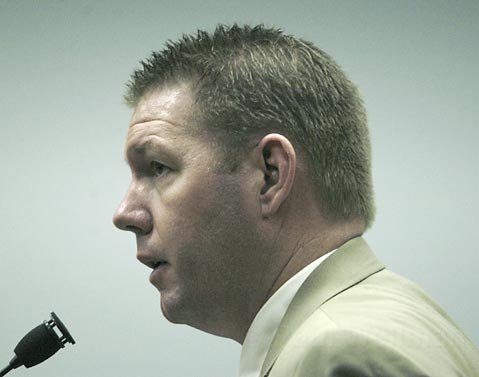
In the past, Sergeant Mike McGrew — compelling and charismatic — has played the role of key union spokesperson. But for the time being, McGrew — whose 18-year-old son recently died after a six-year battle with cancer — has yielded the microphone to Hunter, a hardworking detective assigned to cracking cold cases. Hunter has an insatiable appetite for crunching numbers, and the story those numbers tell, he said, is nothing less than chilling.
Hunter pointed out that City Hall authorized no less than 151 sworn police officers in 2001. Since then, that authorized number — as distinct from the number of in-the-flesh officers on the force and opposed to the number of actual officers ready to report for duty — shrank to 145 and then to 140. This year, Armstrong proposed reducing that number to 133. For the past year, seven of the department’s 140 slots have been vacant. It was Armstrong’s recommendation that those vacancies be made permanent. That was too much for a majority of councilmembers, who urged that four of the seven vacancies be filled, but only if the POA agreed to the wage concessions. (Other unions like SEIU have already agreed to a 6 percent cut. Other unions, like the city’s Management Association, agreed to take whatever cuts the POA agreed to accept. And other unions, like the Firefighters Association, are waiting to see what the POA does before agreeing to anything.)
Hunter contended that with the drop in number of sworn officers, the city’s crime rate increased. “The fewer officers, the higher the reported crime,” he said. But at the same time reported crimes increased, he said, the number of actual arrests has gone down. For example, he said the number of reported grand theft cases increased from 541 to 651 between 2001 and 2009. But the number of grand theft arrests in that same period of time dropped by 28 percent. The number of DUI-caused collisions increased by 200 percent in that time, he said, while DUI arrests dropped by 11 percent.
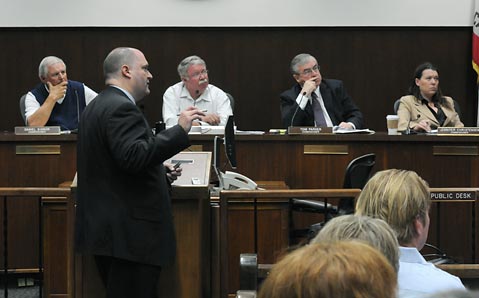
Police service was diminished in less immediate ways as well, he said. People in need have to wait longer for an officer to respond to their calls for service. In 2004, Hunter said, the department goal was to respond to 90 percent of the most serious crime reports — where the risk of death or personal injury were imminent — within four minutes. In 2006, the goal was pushed back to 6.5 minutes. Today, it’s 7.4 minutes. Hunter conceded, however, that in 2009, the department exceeded that goal, averaging a response time of six minutes and 27 seconds for the most serious crime reports. “The more personnel you cut,” he said, “the longer the response time.”
Hunter blamed the reduction in service on a change in budgeting policy initiated by Armstrong in 2004. Rather than budgeting based on maintaining existing levels of service, he said Armstrong shifted to a revenue-based approach. It was designed to encourage entrepreneurialism among department heads and minimize costs. But police and fire departments, he noted, provide the most basic function of government. “If you start telling the police department to make money, people who make the money will get the service,” he said. The people who don’t, won’t.” Hunter noted that the Downtown Organization had the means to hire a retired cop part-time to keep homeless people from harassing downtown shoppers and tourists. The Milpas Street merchants wanted to do the same, but could not afford it. “What are residents who live around the Franklin Center supposed to do?” he asked. “Pass the hat to prevent gangs and drug dealers?”
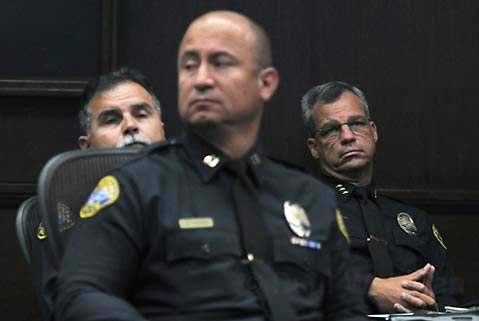
But perhaps most troubling to the fire and police commissioners was Hunter’s assertion that the city’s crime statistics were not just inaccurate but perhaps manipulated to make the departmental response look better than it actually was. For example, he said that a computer search of high priority crime reports in 2009 revealed that 11 calls were “filtered” — not counted — if it took officers more than 30 minutes to respond. Hunter said these calls were “deemed to be anomalies” and set aside. Had they been included, he said, the department’s average response time to serious crimes would be much slower than reported. When asked to elaborate on this by alarmed commissioners, Hunter said he did not have “the data” to do so. Although Deputy Chief Frank Mannix was present — as were two police captains — none of the commissioners sought their response to these anomalies. They scheduled a follow-up meeting to discuss such matters in two weeks.
Chief Cam Sanchez, did not attend the meeting because he was at UCLA with one of his daughters. But in a phone interview, he commented, “I’m really disappointed and personally offended that [Hunter] would say such things. If he has a problem with the accuracy of our numbers, he should have come to me.” Sanchez pledged to respond to Hunter’s comments more fully next week.
In an interview after the meeting, Mannix stated, “Detective Hunter is a very good detective. But he’s not a crime analyst.” Mannix denied that cases were filtered to generate better response times. It was more a function of a new automated computer technology that came with some expensive bells and whistles the department wanted to take advantage of. He noted that only one high priority call was filtered in the past six months, and only 12 in the past 17 months. The most recent involved a bicycle rider who bit the pavement after going over a speed bump. In her case, it was first reported as a potentially life-threatening. But before officers could respond, she’d been transported by ambulance to Cottage Hospital. As a result, no officers ever went to the accident scene.
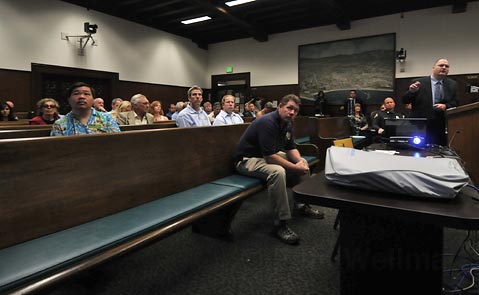
Hunter had charged that one year, Santa Barbara’s Uniform Crime Statistics — officially released by the FBI based on Santa Barbara crime reports — showed there were three homicides when in fact there were only two. This was evidence that the numbers cited by the department were less than infallible. Mannix responded by asking, “Why would we ever over-report homicides if we’re trying to minimize our crime statistics downward? Clearly, we’re not doing a very good job.”
Mannix conceded that the department had faced substantial challenges making do with fewer officers. But he said, the overall picture presented by Hunter was not complete. Crime trends for the past 10 years have gone down in general, he said, not up. In fact, 2007 saw the lowest crime rate in Santa Barbara for the past 20 years. After that, he said crime increased in general for the next two years, but for the first half of 2010, it’s been sharply down again. “He didn’t report the overall trend,” Mannix said. “He reported several key indicators, but not the general picture. He reported in five-year blocks, not what happened in between.” Mannix added, “I agree with some of what he said, but I don’t agree that we’ve reached a level of service that’s substandard. I don’t agree with that at all.”
This year marks the second in a row where the Police and Fire departments have been under intense pressure to undergo significant cuts. Traditionally, these high priority departments have either been spared or let off lighter than other departments, such as Parks and Recreation or Library Services. Last year, the Police Department was forced to accept a modest shave and a haircut, but no authorized positions were cut.
Earlier this year, Armstrong asked the police and fire chiefs to prepare a menu of cuts that totaled 10 percent. For the police, that looked like the loss of 23 positions. When that number was revealed this January — and pink slips were prepared accordingly — POA president Mike McGrew erupted. He accused Armstrong of engaging in “terrorist tactics” in order to win concessions at the bargaining table, and exhibiting poor leadership skills. Ultimately, Armstrong backed down. In the budget he recommended to the City Council, only seven positions were slotted for elimination. Four of those positions have since been restored by the council. And this week, the department hired four new police academy recruits. “The irony is that as of July 1, we’ll have more officers on the force than we did last July 1,” said Mannix. In the meantime, he’s preparing a more exhaustive response to Hunter’s testimony to the Fire and Police Commission.



